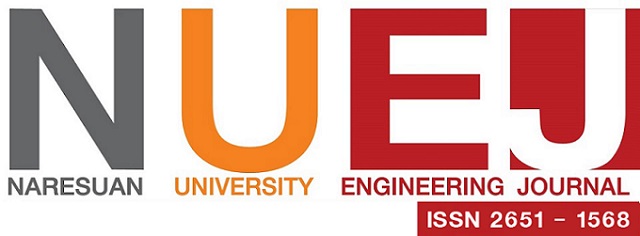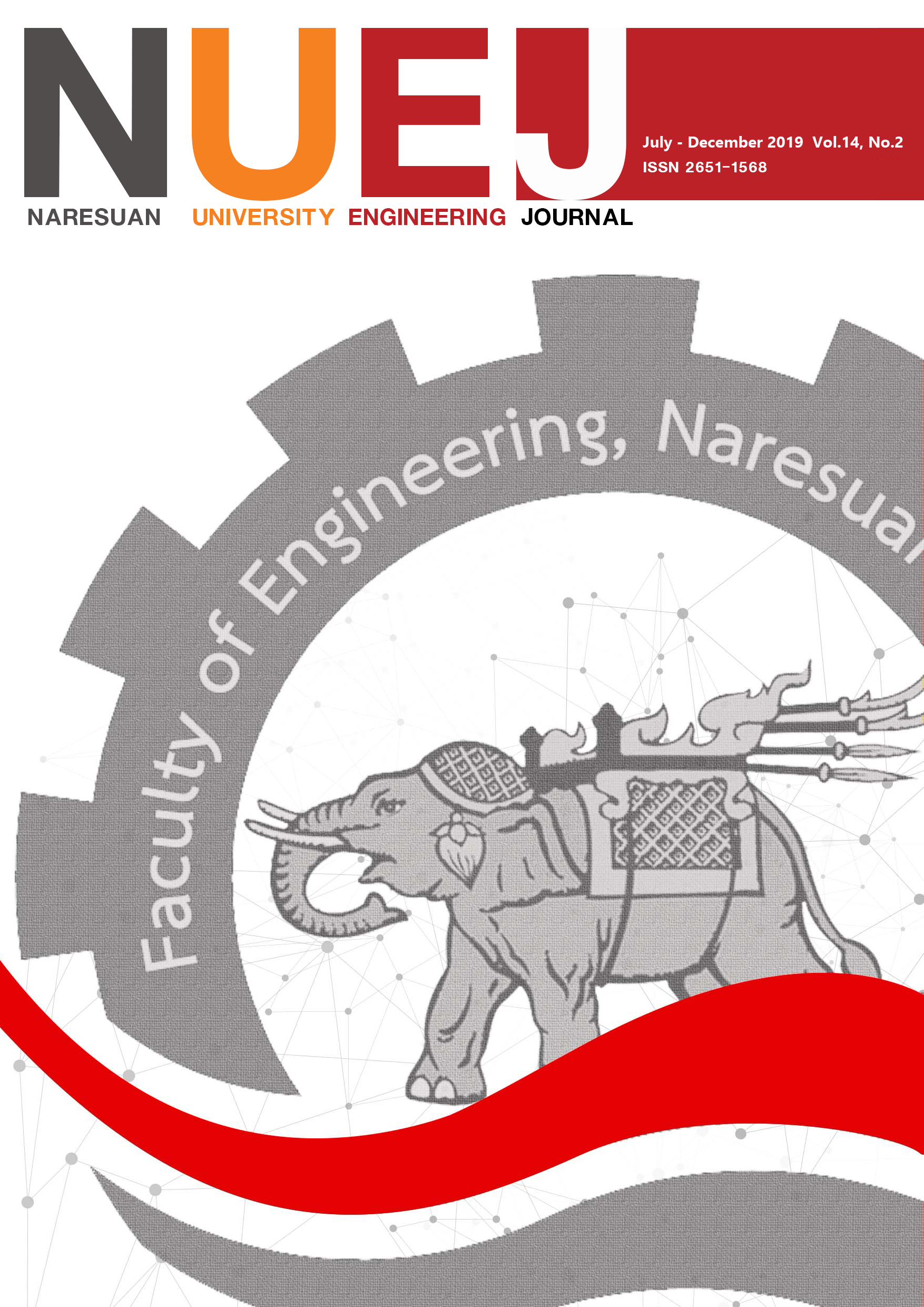การทำนายค่าการสึกหรอด้านข้างคมตัดของมีดกลึงคาร์ไบด์ด้วยโครงข่ายประสาทเทียม แบบแพร่กระจายย้อนกลับ
Main Article Content
บทคัดย่อ
งานวิจัยนี้มุ่งเน้นศึกษาอิทธิพลของปัจจัยในการกลึงปอกเหล็กกล้าไร้สนิมออสเทนนิติก เกรด AISI 316 และเหล็กกล้าไร้สนิม มาร์เทนซิติก เกรด AISI 420 ที่มีผลต่อการสึกหรอของมีดกลึงคาร์ไบด์เคลือบผิวด้วยวิธี CVD มีการออกแบบการทดลองและวิเคราะห์ผลทางสถิติโดยโปรแกรม Minitab และงานวิจัยนี้ได้นำเสนอแบบจำลองโครงข่ายประสาทเทียมแบบแพร่กระจายย้อนกลับในการทำนายค่าการสึกหรอของมีดกลึง ฝึกหัดด้วยวิธี Levenberg-Marquardt (trainlm) กำหนดให้ปัจจัยนำเข้า (Input) ได้แก่ความ เร็วตัด อัตราป้อน และความลึกในการตัด ส่วนผลลัพธ์ (Output) ได้แก่การสึกหรอของมีดกลึงแบบ Flank wear ผลการทดลองพบว่าผลกระทบของปัจจัยหลักและปัจจัยร่วมส่งผลต่อค่าการสึกหรอของมีดกลึงอย่างมีนัยสำคัญ และผลการใช้โครงข่ายประสาทเทียมแบบแพร่กระจายย้อนกลับในการทำนายค่าการสึกหรอของมีดกลึง พบว่ามีค่าเฉลี่ยของค่าความผิดพลาดกำลังสองจากการฝึกหัดมีค่าเท่ากับ 1.23414e-4 และการทดสอบมีค่า 1.50536e-4 สำหรับการตัดเฉือนเหล็กกล้าไร้สนิมออสเทนนิติก เกรด AISI 316 ส่วนการตัดเฉือนเหล็กกล้าไร้สนิมมาร์เทนซิติก เกรด AISI 420 มีค่าเฉลี่ยของค่าความผิดพลาดกำลังสองจากการฝึกหัดมีค่าเท่ากับ 1.45619 e-4 และการทดสอบมีค่า 1.95559e-4 ซึ่งสามารถทำนายค่าได้อย่างแม่นยำและมีค่าความผิดพลาดต่ำ สามารถช่วยวางแผนและการผลิตชิ้นส่วนได้อย่างเหมาะสม เพื่อลดการสิ้นเปลืองเครื่องมือตัด ซึ่งส่งผลต่อต้นทุนการผลิต
Article Details
References
Asilturk, I., & Cunkas, M. (2011). Modeling and prediction of surface roughness in turning operations using artificial neural network and multiple regression method. Expert Systems with Applications, 38, 5826-5832.
Ciftci, I. (2006). Machining of Austenitic Stainless Steel Using CVD Multi-Layer Coated Cemented Carbide Tools. Tribology International, 39, 565-569.
Das, B., Roy, S., Rai, R. N., & Saha, S.C. (2015). Studies on effect of cutting parameters on surface roughness of Al-Cu-TiC MMCs: An Artificial Neural Network Approach. Procedia Computer Science, 45, 745-752.
Ezugwu, E. O., Fadare, D. A., Bonney, J., Da Silva, R. B., & Sales, W. F.(2005). Modelling the correlation between cutting and process parameters in high-speed machining of Inconel 718 alloy using an artificial neural network. International Journal of Machine Tools & Manufacture, 45, 1375-1385.
Filice, L., Micari, F., Settineri, L., & Umbrello, D. (2007). Wear modelling in mild steel orthogonal cutting when using uncoated carbide tools. Wear, 262, 545-554.
Kalidass, S., Palanisamy, P., & Muthukumaran, V. (2012). Prediction of tool wear using regression and artificial neural network models in end milling of AISI 304 Austenitic Stainless Steel. International Journal of Engineering and Innovative Technology (IJEIT), 1, 29-36.
Kant, G., & Sangwan, K. S. (2015). Predictive Modelling and Optimization of Machining Parameters to Minimize Surface Roughness using Artificial Neural Network Coupled with Genetic Algorithm. Procedia CIRP, 31, 453-458.
Krishnakumara, P., Rameshkumarb, K., & Ramachandranc, K. I. (2015). Tool Wear Condition Prediction Using Vibration Signals in High Speed Machining (HSM) of Titanium (Ti-6Al-4V) Alloy. Procedia Computer Science, 50, 270-275.
Milton, C. S. (2005). Metal Cutting Principles. Oxford Series on Advanced Manufacturing.
Özbek, N. A., Çiçek, A., Gülesin, M., & Özbek, O. (2016). Effect of cutting conditions on wear performance of cryogenically treated tungsten carbide inserts in dry turning of tainless steel. Tribology International, 94, 223-233.
Parida, A. K., & Maity, K. (2019). Modeling of machining parameters affecting flank wear and surface roughness in hot turning of Monel-400 using response surface methodology (RSM). Measurement, 137, 375-381.
Phate, M. R., & Toney, S. B. (2019). Modeling and prediction of WEDM performance parameters for Al/SiCp MMC using dimensional analysis and artificial neural network. Engineering Science and Technology an International Journal, 22, 468-476.
Rao, K. V., Murthy, B. S. N., & Rao, N. M. (2014). Prediction of cutting tool wear, surface roughness and vibration of work piece in boring of AISI 316 steel with artificial neural network. Measurement, 51, 63-70.
Smith, W. F. (1993). Structure and properties of engineering alloys (2nd ed.). McGraw-Hill New York.

